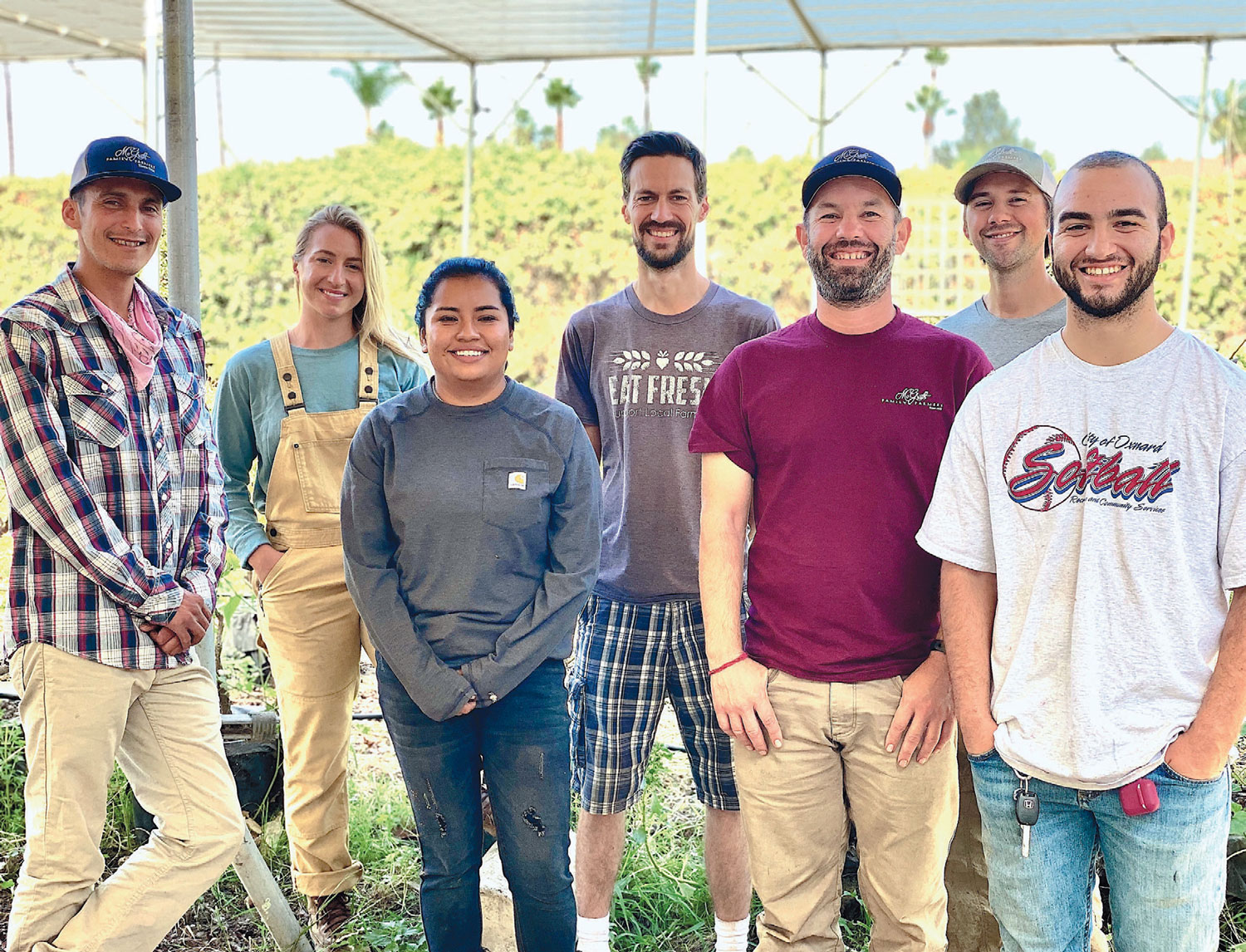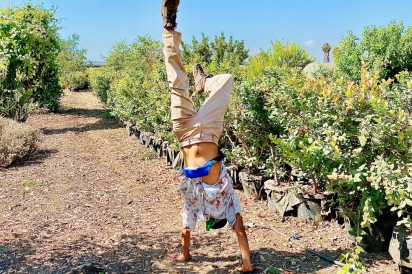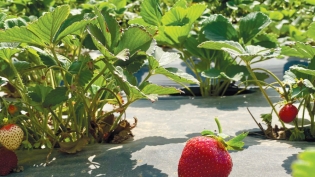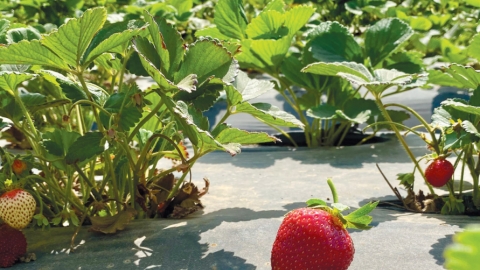McGrath Family Farms Grows Farmers for the Future
Around five years ago, fifth-generation California farmer Phil McGrath began considering retirement. Unbeknownst to him, this transition at McGrath Family Farm set off a series of events culminating in a new enterprise, which is just beginning to take root. Now “retired,” he’s part of McGrath Family Farmers (MFF), a collective that encompasses multiple small farms and a training ground for nascent farmers to learn agriculture firsthand.
The McGrath family has been farming in Ventura County since 1868. Years ago, Phil McGrath and his siblings decided to lease out most of their 300+ acres off Highway 101 in Camarillo for berry cultivation. The remaining 35 acres are now the lifeblood of several farms that practice organic and regenerative farming techniques. The members of MFF include Baby Root Farm, established in 2015 by Mike Roberts, who has worked with McGrath for 10 years. He’s been instrumental in bringing new micro-farms into the collective alongside more established farmers like those at the Carranza Family Farm, one of the premier organic flower growers in the area.
McGrath Family Farm is still active and lends its name, land and infrastructure to the collective; the smaller farms provide much of the energy, labor and output. The farms at MFF reflect the diversity of the area, in age, expertise and ethnicity, which allows for outstanding opportunities for those looking to learn.
‘THE GROUND NEEDS TO REST TOO’
The farmers teach techniques that focus on organic and regenerative cultivation. “Most farmers are monocropping, maybe two or three [crops] if lucky,” says McGrath, 68, describing how farms often grow a single crop to maximize profit. Without diverse crops, the soil is depleted. Add chemical pesticides and herbicides and traditional tilling, and its quality is degraded further. “The last 70 years this area has been over-farmed. Just like anything in nature, the ground needs to rest too. This region was all small family farms, then larger cooperatives, now corporations farm most of VC. But we all get it NOW. There’s only so much water, so much labor, and you can only spray so many times before it just doesn’t work anymore,” says McGrath, adding, “we brought this on ourselves.”
McGrath and the other farmers at MFF see regenerative agriculture as a long-term investment in the region’s ability to produce nutritious, sustainable produce while simultaneously reducing environmental impact. “This point can’t be made strongly enough: Growing and eating what’s in season is the best for you and the environment,” says McGrath. It not only improves the nutrient value of the produce, improving the soil’s microbiology and sequestering carbon, but requires substantially less water and equipment than traditional farming. This allows new and small-scale farmers to rely on “sweat equity” rather than take out loans for major capital investments up front.
‘A GOOD BALANCE’
On the last Saturday of every month, MFF holds “Farm Experience Days,” which, after a brief hiatus, have been able to resume with proper COVID-19 precautions in place. “All the McGrath Farm farmers rotate in hosting,” McGrath says. “There is an introduction with the farmer … then a walking tour of our farms and facilities, participation in a small farm project alongside our farm team and then Q&A.”
Out of these educational afternoons emerged Inlakesh Amor of Living Systems farm and Mateo Palermo of Exit Central, both of whom now have micro-farms as part of MFF.
“I volunteered and it turned into a job, helping the crew harvesting and working the farmers’ markets,” Palermo says. “I began to think, ‘This is something that I could do.’ I love the work of farming. Now I want to be able to teach someone like me who has that interest— at any scale.”
Jeni Carranza, of Carranza Family Farm, is one of his first students. “I’ve really liked learning out in the field alongside everyone on the farm,” Carranza says, smiling. Although she’s been working at farmers’ markets and overseeing operations for produce delivery with Farmivore, she’s excited to be learning more hands-on. MFF farmers typically trade off helping with training and education. “It’s a good balance, and the farm looks more alive.”
‘CAN I SEE YOUR FARM?’
Given the labor-intensive work involved in farming, it’s a wonder that McGrath has made time over the past 20 years for education. “It’s fun,” he laughs. “At the LA markets back in 1992, I began hearing people ask, ‘Can I see your farm?’ and I realized there was an unexplored educational component.” McGrath’s location right off the 101 makes it easier to find and more accessible than many other farms.
By the late 1990s, the farm was hosting scores of visitors, including students. “Between 1997 and 1998, one teacher from Santa Monica brought thousands of students on buses,” McGrath says. “We’d do maybe three tours of an hour each a day.”
MFF continues this tradition of educating young people with local school districts today. “We helped establish the Salad Bar Farms at Balboa Middle School in Ventura,” says Roberts, “and are consulting now on one for Rio School District.”
‘BETTER THAN WE FOUND IT ‘
Recently, the collective piloted its first formal internship, a 21-day intensive, for a Ventura local. Amanda Cox grew up in the Santa Rosa Valley, where she gardened with her mom. Having worked previously at Patagonia, she’d learned about how effective regenerative farming can be in combating climate change.
When the pandemic hit and she wasn’t working, Cox reached out to Roberts at Baby Root Farm to explore her interest in farming. “The challenge for me,” says Cox, “was that I wanted to make a transition [to farming] but I didn’t know where to start.”
Roberts asked her what part of farming she wanted to learn about. “For me, I want to be out in the field—a huge part of the draw is physically working the land. My soul craves that. I feel made for that.” And perhaps it ran in her blood. Her grandfather started off farming and then returned to it after military service and another career.
Although she grew up in more conservative, blue collar world, she’s hopeful about how regenerative agriculture and ranching with organizations like MFF brings together people from different backgrounds. “It’s something unifying where we’re divided on so many things, and a win-win on so many levels—making farmers profitable and self-sustaining and also helping consumers to be healthier.”
“Mike put it best: ‘We grow farmers,’” says McGrath of Roberts, his colleague and friend. “I’d never heard it put like that before, but it’s absolutely true.”
“These farmers will grow regenerative systems of agriculture,” Roberts affirms. “We will share everything we learn in the hope of leaving our world better than we found it.”
For more information visit McGrathFamilyFarmers.com.









